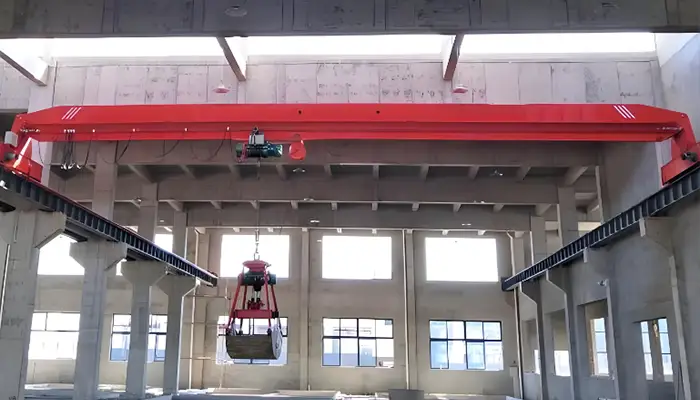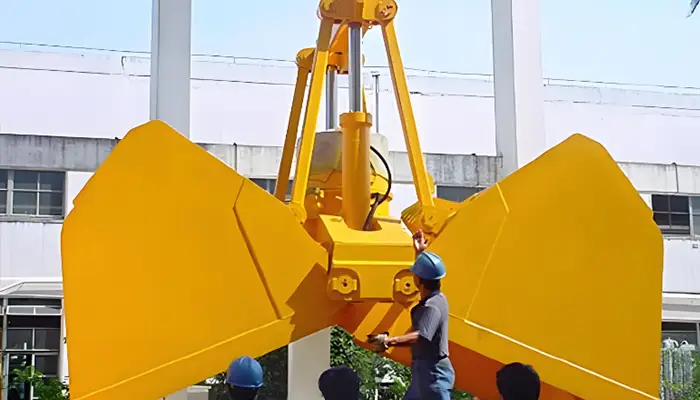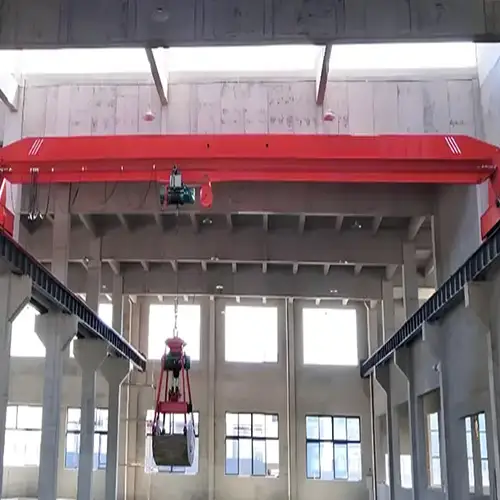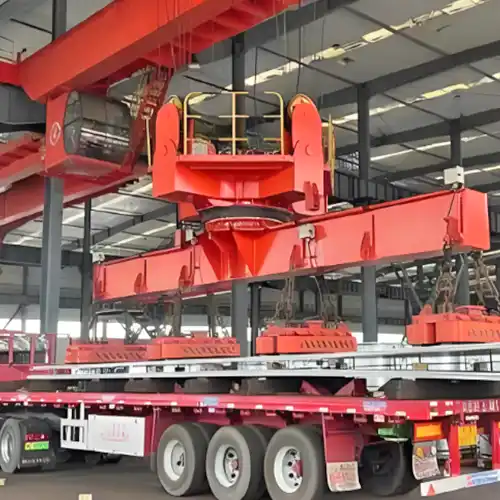Single Girder Top Running Crane in Wallboard Manufacturing
5 ton to 15 tons single girder top running crane in wallboard manufacturing for ash gandling. Cost-effective material handling top running crane for sale.
Category: General Manufacturing
Your Trusted Top Running Crane Manufacturer & Supplier
Single Girder Top Running Crane (5 to 15 Tons) in Wallboard Manufacturing for Ash Handling
5 ton to 15 tons single girder top running crane in wallboard manufacturing for ash gandling. Cost-effective material handling top running crane for sale.
In the construction industry, wallboard, commonly known as drywall or gypsum board, plays a crucial role in building interiors. This versatile product is essential for creating walls and ceilings in residential and commercial spaces. The manufacturing of wallboard involves various materials and processes, with ash handling being a significant component. Efficient ash handling ensures that production runs smoothly and sustainably, making it vital for manufacturers.

Overview of Wallboard Manufacturing
Wallboard manufacturing begins with the key ingredient, gypsum, which is mined and processed into a fine powder. This powder is then mixed with water and various additives, including fly ash. Fly ash, a byproduct from burning coal, is incorporated to enhance the board's properties, such as strength and moisture resistance. The mixture is formed into sheets and dried, resulting in the final wallboard product.
Types of Wallboard Products
Different formulations of wallboard cater to specific needs:
- Standard Gypsum Wallboard: Enhanced with fly ash for improved strength and durability.
- Fire-Resistant Wallboard: Incorporates fly ash to increase fire ratings, making it suitable for safety-conscious applications.
- Moisture-Resistant Wallboard: Designed for humid areas, using fly ash to resist moisture effectively.
- Lightweight Wallboard: Reduces the overall weight for easier handling and installation.
- Specialty Products: Customized wallboards that meet unique performance criteria, such as soundproofing.
Importance of Efficient Ash Handling
Efficient ash handling is critical in wallboard manufacturing, as it directly affects the quality and performance of the final product. Fly ash needs to be managed carefully to ensure consistent mixing and to prevent contamination. Effective handling systems minimize waste and reduce the environmental impact of manufacturing processes. By incorporating fly ash, manufacturers not only enhance product characteristics but also contribute to sustainability by recycling a byproduct.
Role of Single Girder Top Running Cranes in the Production Process
Single girder top running cranes are essential in the wallboard manufacturing process, especially for ash handling. These cranes offer several advantages:
- Space Efficiency: Their design allows for maximum lifting height and spans, making them ideal for facilities with limited vertical space.
- Load Handling: Capable of lifting loads between 5 to 15 tons, these cranes are perfect for transporting bulk bags of fly ash and other materials throughout the production line.
- Flexibility: The use of below hook devices like spreader beams and vacuum lifters enhances their versatility, allowing for efficient handling of different types of loads.
- Safety and Control: Equipped with precision control systems, these cranes ensure safe and accurate movements, reducing the risk of accidents in busy manufacturing environments.
In summary, single girder top running cranes play a vital role in optimizing the wallboard manufacturing process, particularly in the handling of ash. Their efficiency and effectiveness contribute significantly to the overall productivity and sustainability of wallboard production.
Typical Crane System
Single Girder Overhead Cranes
Definition and Design Features
Single girder overhead cranes consist of a single beam (or girder) that supports the lifting mechanism and travels along elevated tracks. This design allows for efficient lifting and movement of materials in various industrial applications. The crane's simple structure enables it to operate in confined spaces while maintaining a high lifting capacity.
Advantages for Wallboard Manufacturing
In wallboard manufacturing, single girder overhead cranes offer several key benefits:
- Space Efficiency: Their compact design maximizes vertical lifting height and minimizes the footprint, making them ideal for facilities with limited space.
- Cost-Effectiveness: Generally more affordable than double girder systems, single girder cranes provide a reliable solution for managing production without significant capital investment.
- Ease of Operation: With straightforward controls, these cranes can be operated efficiently, reducing training time for staff and increasing productivity.
Applications in Ash Handling
Single girder overhead cranes are particularly valuable for ash handling in wallboard production. They facilitate:
- Loading and Unloading: Efficiently moving bulk bags of fly ash to and from storage areas.
- Transporting Ash: Carrying ash from delivery trucks to mixing stations, ensuring a continuous supply for production.
- Distribution: Allowing for the effective handling of ash throughout various stages of the manufacturing process.
Typical Ash Handled
Overview of Types of Ash Used
In wallboard manufacturing, different types of ash can be utilized, with fly ash being the most common. Other types, such as bottom ash and coal ash, may also be used but to a lesser extent. Each type of ash has unique properties that can enhance the wallboard's performance.
Fly Ash Characteristics and Benefits in Wallboard Production
Characteristics:
Fly ash is a fine, powdery substance collected from the flue gases of coal-fired power plants. It consists primarily of silica, alumina, and iron, giving it specific properties that contribute positively to wallboard manufacturing.
Benefits:
- Strength Improvement: The incorporation of fly ash enhances the compressive strength of gypsum wallboard, making it more durable.
- Weight Reduction: Fly ash reduces the overall weight of the wallboard, facilitating easier handling and installation.
- Moisture Resistance: Its chemical composition helps improve moisture resistance, making it suitable for various applications, including humid environments.
Importance of Effective Handling
Proper handling of fly ash is crucial for maintaining its quality and effectiveness. Efficient ash handling systems prevent contamination, ensure consistent mixing with gypsum, and minimize waste. By investing in reliable crane systems and handling techniques, manufacturers can enhance product quality, optimize production processes, and promote sustainability through the effective use of fly ash.
Ash Handling in Wallboard Manufacturing
Standard Gypsum Wallboard
Composition: Standard gypsum wallboard is produced by mixing gypsum with fly ash, which enhances the board's structural integrity and overall performance. The fly ash contributes to a smoother finish and better adhesion.
Benefits of Fly Ash: The use of fly ash improves the strength and durability of the wallboard, allowing it to withstand impacts and stress during installation and use.
Crane Application: In the production of standard gypsum wallboard, single girder overhead cranes are employed to move bulk bags of fly ash to the mixing area. These cranes are designed with precision controls that facilitate the quick and safe loading of materials, reducing downtime and ensuring a steady workflow.
Typical Crane Design and Capacity Range: Single girder overhead cranes typically have a lifting capacity of 5 to 15 tons. This range is suitable for handling the weight of bulk fly ash and finished wallboard, optimizing the efficiency of the production process.
Fire-Resistant Wallboard
Composition: Fire-resistant wallboard incorporates fly ash to improve its fire safety features. The formulation is designed to meet specific fire rating standards required for various building codes.
Benefits of Fly Ash: The addition of fly ash not only enhances the board's fire resistance but also improves its overall thermal properties, making it an excellent choice for safety-conscious applications.
Crane Application: Overhead cranes are critical in transporting raw materials, including fly ash and other additives, to the production line. These cranes allow for seamless movement from storage to mixing, which is crucial for maintaining consistent quality.
Typical Crane Design and Capacity Range: Similar to standard gypsum wallboard, the cranes used for fire-resistant wallboard also have a capacity range of 5 to 15 tons, enabling them to handle the heavier materials used in fire-rated formulations.
Moisture-Resistant Wallboard
Composition: Moisture-resistant wallboard features fly ash blended with special additives that provide enhanced resistance to water and humidity, making it ideal for areas prone to dampness.
Benefits of Fly Ash: Fly ash improves the board's ability to resist moisture infiltration, reducing the risk of mold growth and increasing the longevity of the wallboard in humid environments like kitchens and bathrooms.
Crane Application: Overhead cranes facilitate the efficient transport of moisture-resistant wallboard during production and storage. These cranes help manage inventory by moving finished boards to shipping areas or temporary storage without risk of damage.
Typical Crane Design and Capacity Range: The overhead cranes used in this application also have a lifting capacity between 5 to 15 tons, making them suitable for both the raw materials and finished products.
Lightweight Wallboard
Composition: Lightweight wallboard incorporates fly ash to reduce the overall weight of the board while maintaining structural integrity. This innovation is particularly valuable in applications where weight is a critical factor.
Benefits of Fly Ash: The reduction in weight leads to easier handling and installation, which can significantly lower labor costs and installation time on job sites.
Crane Application: Cranes are essential for moving lightweight wallboard throughout the production line. Their precision allows for quick transitions between stages of production, ensuring a streamlined workflow.
Typical Crane Design and Capacity Range: Single girder overhead cranes with a capacity of 5 to 15 tons are ideal for this application, as they can easily lift and maneuver lightweight boards while ensuring safety and efficiency.
Specialty Wallboard Products
Composition: Specialty wallboards use customized formulations of fly ash tailored for specific performance criteria, such as soundproofing or thermal insulation.
Benefits of Fly Ash: By enhancing specific properties, fly ash helps meet the unique demands of niche markets, making these products highly versatile.
Crane Application: Cranes are utilized to manage the diverse materials needed for specialty wallboard production, allowing manufacturers to adapt quickly to changing demands and specifications.
Typical Crane Design and Capacity Range: For specialty wallboard products, cranes are typically designed to handle loads in the 5 to 15 ton range, accommodating the varied materials and ensuring effective material handling throughout the production process.
Single girder overhead cranes are pivotal in the wallboard manufacturing process, particularly for ash handling. Their ability to efficiently transport materials while maintaining safety and flexibility enhances productivity and quality across various wallboard types. The integration of fly ash not only improves the performance characteristics of the final products but also supports sustainable manufacturing practices, making these cranes essential in modern production facilities.

Below Hook Devices
Spreader Beams
Functionality and Design: Spreader beams are specialized lifting devices designed to distribute the load evenly across multiple lifting points. This ensures stability and minimizes the risk of damage to the load during transportation. Typically constructed from high-strength materials, they are engineered to handle significant weight while maintaining structural integrity.
Applications in Lifting Bulk Bags of Fly Ash: In wallboard manufacturing, spreader beams are commonly used to lift bulk bags of fly ash. By providing multiple lifting points, these beams help manage the inherent instability of bulk bags, allowing for safer handling during transportation to the mixing area.
Advantages for Stability and Load Distribution: The primary advantage of using spreader beams is their ability to distribute weight evenly, reducing stress on both the load and the lifting equipment. This stability is crucial when moving heavy bulk materials like fly ash, as it helps prevent shifting or tipping during transport.
Vacuum Lifters
Mechanism of Operation: Vacuum lifters operate using suction to securely grip and lift loads. They create a vacuum between the lifter and the surface of the material, which allows for safe and efficient handling of various types of materials, including loose fly ash.
Benefits in Handling Loose Fly Ash: Vacuum lifters are particularly advantageous for handling loose fly ash, as they provide a gentle yet firm grip without damaging the material. This is especially important in wallboard manufacturing, where the quality of the fly ash can directly impact the properties of the final product.
Use Cases in Loading and Unloading Processes: In the loading and unloading processes, vacuum lifters streamline operations by enabling quick transfers of materials. They are especially useful in moving loose fly ash from storage containers to mixing equipment, enhancing overall efficiency and minimizing labor costs.
Overall, below hook devices like spreader beams and vacuum lifters play a vital role in the effective handling of materials in wallboard manufacturing, ensuring safety, stability, and operational efficiency.
Typical Crane Capacity Range
Capacity Overview
Explanation of 5 to 15 Tons Capacity: Cranes used in wallboard manufacturing typically have a lifting capacity of 5 to 15 tons. This range is specifically designed to handle the weights of materials essential for production, including bulk bags of fly ash, finished wallboard, and various additives.
Importance of Capacity Selection in Wallboard Manufacturing: Choosing the right crane capacity is critical. If the capacity is too low, it can lead to overloading, which poses safety risks and may damage the crane. For example, attempting to lift a 1-ton bulk bag of fly ash with an inadequately rated crane could cause strain or failure. On the other hand, selecting a crane with too much capacity can increase operational costs and energy consumption. Therefore, accurately assessing the load requirements based on production needs is vital for maintaining safety and efficiency in manufacturing operations.
Load Handling Examples
Common Loads Handled Within the Specified Capacity: Cranes in the 5 to 15 tons capacity range are used to handle various loads, such as:
- Bulk Bags of Fly Ash: Typically weighing around 1 ton each, these bags are essential for mixing with gypsum.
- Finished Gypsum Wallboard Sheets: Depending on thickness, each sheet can weigh between 50 to 100 pounds, making it feasible to lift multiple sheets at once.
- Additives and Other Raw Materials: Various other materials, like fiberglass or moisture-resistant agents, can also be lifted, usually weighing several hundred pounds each.
Case Studies or Scenarios of Crane Utilization:
- Scenario 1: In a busy manufacturing facility, a crane with a 10-ton capacity is utilized to lift multiple 1-ton bulk bags of fly ash. The operator uses the crane to efficiently load four bags at once onto the mixing line, significantly reducing the time spent on material transport. This not only speeds up the production cycle but also minimizes manual handling, reducing the risk of injury.
- Scenario 2: During a project focused on producing fire-resistant wallboard, the production team needs to transport heavier additives along with fly ash. A crane with a 15-ton capacity lifts a combined load of five bags (1 ton each) of fly ash and additional fire-resistant materials. The ability to handle this load simultaneously allows the team to maintain a continuous workflow, ensuring the production schedule stays on track and meets customer demands.
These practical examples highlight how selecting the appropriate crane capacity can enhance efficiency, ensure safety, and facilitate smoother operations in wallboard manufacturing.
Special Crane Design Features
Lightweight Design for Efficiency
Benefits of Reduced Weight: A lightweight crane design significantly enhances operational efficiency. Reduced weight allows for easier maneuverability and faster operation, which is crucial in a fast-paced manufacturing environment like wallboard production. This feature also contributes to less wear and tear on the building structure, as the overall load is minimized.
Impact on Energy Consumption and Installation Ease: Lightweight cranes require less energy to operate, leading to lower utility costs. Additionally, their reduced weight simplifies the installation process, often allowing for quicker setups and fewer structural reinforcements. This not only saves time but also minimizes disruption during installation.
Precision Control Systems
Description of Advanced Control Technologies: Modern cranes are equipped with advanced control technologies that provide precise handling of loads. Features such as programmable logic controllers (PLCs) and remote control systems allow operators to manage movements with high accuracy, ensuring safe and efficient operations.
Importance of Precision in Load Handling and Safety: Precision control systems are vital in wallboard manufacturing, where accurate load positioning can prevent material damage and enhance safety. For instance, when handling bulk bags of fly ash, precise movements reduce the risk of spillage or accidents, ensuring that materials are delivered safely to the mixing area.
Easy-to-Maintain Components
Design Considerations for Maintenance: Cranes designed with maintenance in mind often feature accessible components that facilitate routine checks and repairs. This includes using standardized parts that are easy to replace and ensuring that critical components are positioned for quick inspection.
Benefits of Minimizing Downtime and Repair Costs: By prioritizing ease of maintenance, manufacturers can significantly reduce downtime associated with repairs. This leads to increased productivity and lower overall maintenance costs. For instance, a crane that requires less frequent repairs allows the wallboard production line to operate smoothly, preventing interruptions that could delay project timelines.
In summary, these special crane design features—lightweight construction, precision control systems, and easy maintenance—collectively enhance the efficiency, safety, and reliability of cranes in wallboard manufacturing, ensuring that production processes are optimized for performance.
Design Considerations
Space Constraints
Factors Influencing Design in Manufacturing Facilities: In wallboard manufacturing, space constraints are a critical factor in crane design. Facilities often have limited vertical and horizontal space, which necessitates careful planning. The layout of equipment, materials, and workflow paths must be taken into account to ensure that the crane can operate effectively without hindering other operations.
Strategies for Optimizing Crane Placement and Movement: To optimize crane placement, manufacturers can utilize overhead space by installing cranes along the facility's length. Implementing a gantry or bridge system can maximize coverage while minimizing the footprint. Additionally, using intelligent layout designs, such as U-shaped or circular workflows, can facilitate smoother crane movements and reduce unnecessary travel distances, enhancing overall operational efficiency.
Material Handling Workflow
Overview of Typical Workflows in Ash Handling: The material handling workflow in wallboard manufacturing typically involves transporting bulk fly ash from storage to the mixing area, followed by moving the mixed materials to the production line. This process must be seamless to maintain productivity and ensure that materials are handled efficiently.
Integration of Cranes into Existing Material Handling Processes: Integrating cranes into existing workflows requires an understanding of the specific tasks and timing involved in material handling. For instance, cranes should be positioned to allow for quick loading and unloading of bulk bags of fly ash without causing bottlenecks. Synchronizing crane operations with conveyor systems can further enhance material flow, ensuring that production remains uninterrupted.
Load Handling Efficiency
Importance of Efficiency in Material Transport: Load handling efficiency is crucial in wallboard manufacturing, where time is a critical factor. The faster and more efficiently materials are transported, the more product can be produced within a given timeframe. This not only improves output but also reduces labor costs associated with material handling.
Techniques for Enhancing Load Handling Capabilities: Several techniques can enhance load handling capabilities, including:
- Automated Controls: Implementing automated systems for load positioning can reduce operator error and speed up operations.
- Load Monitoring Systems: Using load cells and sensors to monitor the weight of materials being lifted ensures that the crane operates within safe limits and can help optimize load distribution.
- Training for Operators: Ensuring that operators are well-trained in using cranes and understanding load dynamics can significantly improve handling efficiency and safety.
In summary, careful consideration of design factors such as space constraints, material handling workflows, and load handling efficiency is essential in optimizing crane operations in wallboard manufacturing. By implementing these strategies, manufacturers can enhance productivity and ensure smooth operations in their facilities.
Buying Tips
Choose a Reputable Supplier
Importance of Supplier Reliability and Reputation: Selecting a reliable supplier is crucial for the long-term success of your crane investment. A reputable supplier will not only provide high-quality equipment but also offer dependable customer service, maintenance support, and warranty options. This ensures that any issues can be addressed quickly, minimizing downtime.
Criteria for Selecting a Trusted Supplier: When choosing a supplier, consider their industry experience, customer reviews, and after-sales support. Look for certifications and compliance with industry standards, as these indicate a commitment to quality and safety. Additionally, ask for case studies or references from other wallboard manufacturers to assess the supplier's reliability in similar applications.
Assess Compatibility with Existing Systems
Factors to Consider for System Integration: Before purchasing a crane, evaluate how it will fit into your existing manufacturing setup. Consider factors such as the crane's dimensions, lifting capacity, and operational requirements. Ensure that it aligns with your current material handling processes and workflows to prevent disruptions.
Importance of Ensuring Compatibility with Current Equipment: Ensuring compatibility with existing equipment, such as conveyors, mixers, and other handling systems, is vital. An incompatible crane can lead to inefficiencies, increased labor costs, and potential safety hazards. Conduct a thorough analysis of your current systems and consult with engineers to confirm that the new crane will integrate smoothly.
Consider Future Capacity Needs
Planning for Growth and Scalability in Production: When selecting a crane, it's essential to consider not just current needs but also future capacity requirements. As your wallboard manufacturing operation grows, your material handling demands may increase. Choosing a crane with the ability to scale will help accommodate higher production volumes without requiring a complete equipment overhaul.
Importance of Foresight in Capacity Selection: Being forward-thinking in capacity selection can save time and money in the long run. Anticipating future needs allows you to invest in a crane that will remain relevant as production demands evolve, preventing the need for frequent upgrades or replacements. This strategic approach helps maintain efficiency and competitiveness in the market.
In conclusion, when purchasing a crane for wallboard manufacturing, focusing on a reputable supplier, ensuring compatibility with existing systems, and planning for future capacity needs will lead to a more effective investment. These buying tips will help you make informed decisions that support long-term operational success.
Conclusion
In summary, single girder cranes play a pivotal role in wallboard manufacturing and ash handling, providing efficient solutions for moving essential materials like fly ash. Their lightweight design, precision control systems, and compatibility with below hook devices such as spreader beams and vacuum lifters enhance operational efficiency. Additionally, understanding the various types of wallboard that utilize fly ash—such as standard, fire-resistant, and moisture-resistant wallboard—illustrates the importance of effective crane operations in achieving high-quality production.
Final thoughts emphasize the need for manufacturers to focus on optimizing crane design and operations to enhance overall efficiency and sustainability. By investing in the right crane technology and ensuring proper integration within the production workflow, companies can significantly improve their manufacturing processes, reduce environmental impact, and meet growing market demands.
Related Products

Latest project
150 Ton Overhead Crane Installation Feedback – Paraguay Case
QDX 150 ton overhead crane in action in Paraguay. Installation photos, video, and client feedback show performance, safety, and heavy-lifting efficiency.
Free consultation to Confirm Parameters & Specifications and Get
Latest Crane Price & Crane Rate.
- Types of overhead cranes : _______?
- Optional: Overhead travelling crane, goliath gantry crane,Slewing jib crane, Single girder or double girder crane,small portable crane or kbk crane, etc.
- Capacity of overhead crane: _______?
- Optional: 0.25ton, 0.5 ton, 1 ton, 2 ton, 3ton, 5 ton, 10 ton,15ton, 20ton, 25 ton, 30ton,35ton, up to 550ton, etc.
- Crane span & lifting height : _______?
- Crane travelling length : _____?
- Control of overhead crane:_______?
- Optional: pendant/ remote/cabin control
- Voltage supply of overhead crane:_____?
- Eg,: 380V50/60HZ,3Phase or others,etc.
- Application/usage of crane:_______?
- Eg,: Steel mill, ,injection mold, cement,stone, concrete,granite, general manufacturing, etc.
Just leave a message via the contact form and our hoist and crane engineer will contact you with in 24working hours.
Get In Touch



